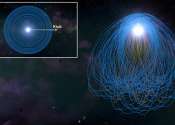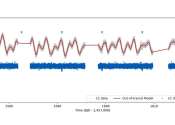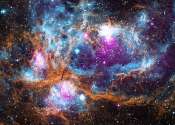Last update:
Astronomy & Space news

Hungry, hungry white dwarfs: Solving the puzzle of stellar metal pollution
Dead stars known as white dwarfs, have a mass like the sun while being similar in size to Earth. They are common in our galaxy, as 97% of stars are white dwarfs. As stars reach the end of their lives, their cores collapse ...
Astronomy
6 hours ago
0
115

Astronomers inspect population of young stellar objects in open cluster NGC 346
Using the James Webb Space Telescope (JWST), an international team of astronomers has explored young stellar objects (YSOs) in an open cluster known as NGC 346. The study, published April 24 on the preprint server arXiv, ...

The Eta Aquarid meteor shower, debris of Halley's comet, peaks this weekend. Here's how to see it
The Eta Aquarid meteor shower, remnants of Halley's comet, peaks this weekend. And with just a waning crescent moon in the sky, it should be visible.
Space Exploration
10 hours ago
0
103

Solar orbiter takes a mind-boggling video of the sun
You've seen the sun, but you've never seen the sun like this. This single frame from a video captured by ESA's Solar Orbiter mission shows the sun looking very fluffy! You can see feathery, hair-like structures made of plasma ...
Astronomy
8 hours ago
0
35

What can AI learn about the universe?
Artificial intelligence and machine learning have become ubiquitous, with applications ranging from data analysis, cybersecurity, pharmaceutical development, music composition, and artistic renderings.
Astronomy
9 hours ago
0
25

Making sure ESA's cloud and aerosol satellite is aerosol-free
A few weeks ago, a team of engineers carefully extracted ESA's EarthCARE satellite from its protective transport container, initiating a meticulous process of inspection, testing and preparation for its liftoff later this ...
Space Exploration
9 hours ago
0
38

Ariane 6 launches: Exolaunch's EXOpod Nova
Europe's newest rocket soon launches, taking with it many space missions each with a unique objective, destination and team at home, cheering them on. Whether launching new satellites to look back and study Earth, peer out ...
Space Exploration
9 hours ago
0
1

Earth from space: Namibian landforms
This image may resemble the surface of Mars, but it was actually captured by the Copernicus Sentinel-2 mission, revealing the stunning terrain of northwest Namibia.
Planetary Sciences
9 hours ago
0
0

China sends a probe to get samples from the less-explored far side of the moon
China on Friday launched a lunar probe to land on the far side of the moon and return with samples that could provide insights into differences between the less-explored region and the better-known near side.
Space Exploration
17 hours ago
0
88

TOI-837 b is a young Saturn-sized exoplanet with a massive core, observations find
European astronomers have performed photometric and spectroscopic observations of a distant giant exoplanet known as TOI-837 b. As a result, they found that TOI-837 b is a young Saturn-sized planet containing a massive core, ...

Fluidic telescope (FLUTE): Enabling the next generation of large space observatories
The future of space-based UV/optical/IR astronomy requires ever larger telescopes. The highest priority astrophysics targets, including Earth-like exoplanets, first generation stars, and early galaxies, are all extremely ...
Astronomy
May 2, 2024
2
51

Webb telescope probably didn't find life on an exoplanet—yet
Recent reports of NASA's James Webb Space Telescope finding signs of life on a distant planet understandably sparked excitement. A new study challenges this finding, but also outlines how the telescope might verify the presence ...
Astrobiology
May 2, 2024
0
52

Intercropping viable for optimizing vegetable production on Mars
A group of crop systems analysts at Wageningen University and Research, in the Netherlands, has found evidence that intercropping on Mars could be a viable option for optimizing vegetable production.

X-ray satellite XMM-Newton sees 'space clover' in a new light
Astronomers have discovered enormous circular radio features of unknown origin around some galaxies. Now, new observations of one dubbed the Cloverleaf suggest it was created by clashing groups of galaxies.
Astronomy
May 2, 2024
0
56

Two small NASA satellites will measure soil moisture, volcanic gases
Two NASA pathfinding missions were recently deployed into low-Earth orbit, where they are demonstrating novel technologies for observing atmospheric gases, measuring freshwater, and even detecting signs of potential volcanic ...
Planetary Sciences
May 2, 2024
0
16

China set to blast off to the far side of the moon—here's what it could discover
China is attempting to recover the first ever soil and rock samples from the lunar far side. The surface mission, Chang'e 6, named after the Chinese moon goddess Chang'e, is a successor to the successful sample return mission, ...
Space Exploration
May 2, 2024
0
17

Pulsed plasma rocket (PPR): Shielded, fast transits for humans to Mars
The future of a space-faring civilization will depend on the ability to move both cargo and humans efficiently and rapidly. Due to the extremely large distances that are involved in space travel, the spacecraft must reach ...
Space Exploration
May 2, 2024
1
25

Japanese aerospace company captures an actual picture of space debris
Space debris is a growing problem, so companies are working on ways to mitigate it. A new satellite called ADRAS-J was built and launched to demonstrate how a spacecraft could rendezvous with a piece of space junk, paving ...
Space Exploration
May 2, 2024
0
17

The Great Observatory for Long Wavelengths (GO-LoW) proposal
Humankind has never before seen the low frequency radio sky. It is hidden from ground-based telescopes by the Earth's ionosphere and challenging to access from space with traditional missions because the long wavelengths ...
Astronomy
May 2, 2024
0
31

A 'cosmic glitch' in gravity: New model may explain strange behavior on a cosmic scale
A group of researchers at the University of Waterloo and the University of British Columbia have discovered a potential "cosmic glitch" in the universe's gravity, explaining its strange behavior on a cosmic scale.
Astronomy
May 1, 2024
7
375
More news

NASA does Dragon shuffle prepping for Starliner launch

NASA balloons head north of Arctic Circle for long-duration flights

Enceladus spills its guts through strike–slip motion

JWST uses interferometry mode to reveal two protoplanets around a young star

Launch date set for NASA's PREFIRE mission to study polar energy loss

Two new satellites join the Galileo constellation

Chinese astronauts return to Earth after 6 months on space station
Other news

Lego-pushing bumblebees reveal insect collaboration dynamics

How E. coli get the power to cause urinary tract infections

Chemist explores the real-world science of Star Wars

Novel triple drug combination effective against antibiotic-resistant bacteria

Probing the effects of interplanetary space on asteroid Ryugu

New study reveals mystery of decaying exoplanet orbits

NASA scientists gear up for solar storms at Mars

How mantle movements shape Earth's surface

New discovery of a mechanism that controls cell division

Cold sintering may rescue plastic, ceramics, battery components from landfills

Physicists pioneer new quantum sensing platform

Lake tsunamis pose significant threat under warming climate


















































